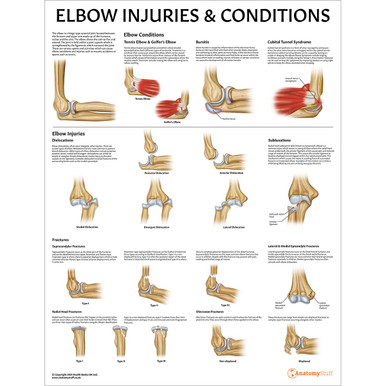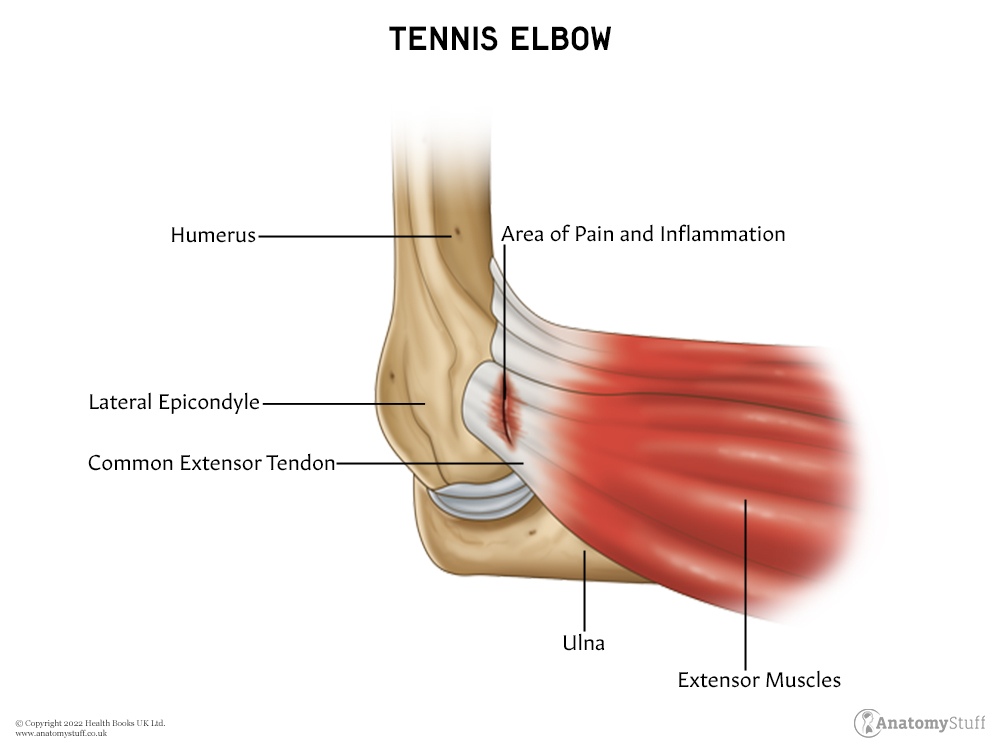How To Manage Tennis Elbow at Home
Tennis elbow, also known by its medical term, lateral epicondylitis, is a condition that strains your forearm muscles. Although the name suggests, the disorder isn’t directly linked to tennis. Vigorous physical activity can make it worse.
If you’re diagnosed with tennis elbow, the ideal way to cure this painful condition at home is by practising exercises and following self-help tips. To know more about the management of tennis elbow, head down below.
If you want to know more about tennis elbow or any other injury, check out our range of models and charts to help you understand the conditions better.
What Is Tennis Elbow?
Tennis elbow causes inflammation or tears in the tendons of your forearm muscles that attach to the outside of the elbow joint. The damage to your forearm muscles primarily happens when you repeat the same movements frequently, often known as an overuse injury. This provokes pain and tenderness over the lateral side of your elbow.
What Are the Symptoms Of Tennis Elbow?
You will develop the symptoms of tennis elbow gradually. Although, your pain can get severe over a few weeks or even months. Additionally, you won’t find any specific pattern at the beginning of your symptoms.
The common signs and symptoms of tennis elbow are:
⦁ Intense pain and burning sensation over the lateral part of your elbow
⦁ Weakness while gripping things with your affected hand
⦁ Pain that aggravates during nighttime
Your symptoms worsen after performing activities such as twisting movements, shaking hands, or carrying a racquet. However, you’re more likely to have tennis elbow in your dominant hand. Although, both arms will get affected in rare cases.
What Is the Treatment Of Tennis Elbow?
Your doctor will diagnose your condition first by taking a history of your symptoms and running routine tests such as MRI and X-Ray to rule out other possibilities. Once you’re diagnosed with tennis elbow, your healthcare professional will advise following non-surgical treatments to cure your tennis elbow.
These includes:
⦁ Complete Arm Rest
⦁ Medications – for pain
⦁ Physical Therapy to improve muscle function
⦁ A brace to resolve pain and tenderness
⦁ Steroid Injections to minimize signs of inflammation
⦁ Platelet-rich plasma and Shock Wave Therapy to stimulate tissue healing
However, if your symptoms don’t resolve within 6 to 12 months, your healthcare professional might advise attaining a surgical procedure for complete recovery.
4 Exercises to Cure Tennis Elbow at Home
The following exercises can help you in managing your tennis elbow at home:
Wrist Turn
⦁ Move the elbow to 90 degrees
⦁ Straighten your hand, palm facing upwards
⦁ Move the palm downwards to twist your wrist
⦁ Stay in this position for 5 second
⦁ Perform 10 repetitions of this exercise twice daily
Wrist Lift
⦁ Hold a light weight in your affected hand, such as a water bottle
⦁ Bend your elbow at 90 degree
⦁ Straighten your hand, palm facing upwards
⦁ Bend your wrist towards your body
⦁ Stay in this position for 5 seconds
⦁ Perform 10 repetitions of this exercise twice daily
Wrist Extensor Stretch
⦁ Straighten your affected arm in front of your body
⦁ With your palm facing upwards, bend your wrist down
⦁ Use your other hand to pull your stretching hand near your body
⦁ Stay in this position for 15 to 30 seconds before releasing your hand
⦁ Perform 3 repetitions of this exercise twice daily
Fist Squeeze
⦁ Take a tennis ball, sock, or rolled-up towel in your palm
⦁ Grip the ball with your finger and give a squeeze by making a fist
⦁ Hold your squeeze for 10 seconds
⦁ Perform 10 repetitions of this exercise twice daily
3 Self-Help Tips to Treat Tennis Elbow at Home
Your symptoms of tennis elbow are more likely to resolve within 2 weeks by following these self-help tips that include:
⦁ Stop doing vigorous activity with your affected hand
⦁ Use an ice pack, heat pad, or hot water bottle to ease inflammation caused by tennis elbow
⦁ Take over-the-counter painkillers
Conclusion
Getting a tennis elbow is relatively normal if you’re overusing your forearm muscle or doing a strenuous activity regularly. However, it’s not serious and is easily managed by following the exercises above and self-help tips.
For more information on how to manage tennis elbow at home, take a look at our tennis elbow patient education information.
Related products
View All












